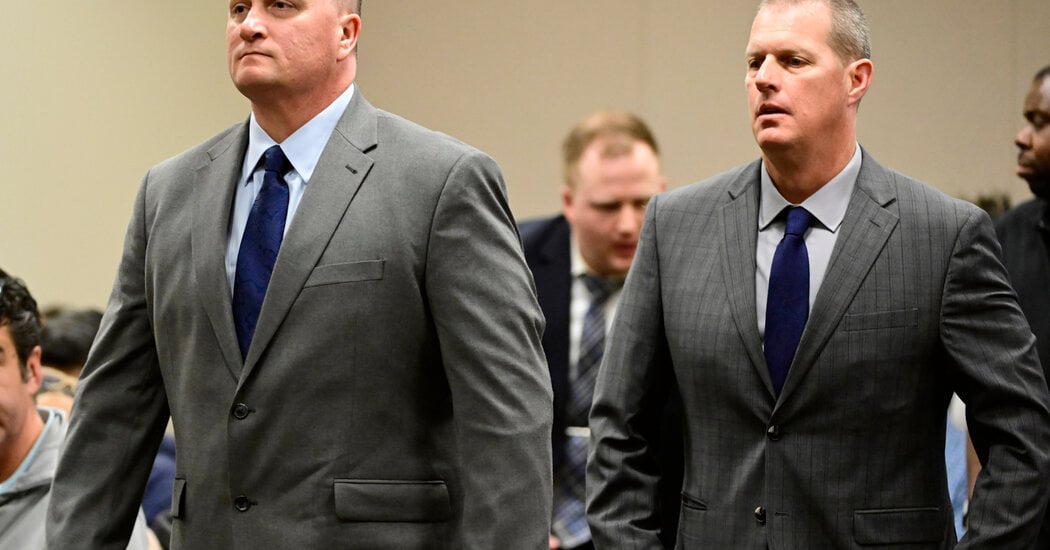Two Colorado paramedics were convicted of criminally negligent homicide in the 2019 death of Elijah McClain, a young unarmed Black man whose case drew national attention and forced public safety reforms in the city where he lived and died.
A mostly white jury found the paramedics, Peter Cichuniec and Jeremy Cooper, guilty of a more serious charge they faced. But the jury split on two lesser assault charges: They cleared Mr. Cooper of both assault charges, but convicted Mr. Cichuniec of one of those charges, second-degree assault for the unlawful administration of drugs.
The men had injected Mr. McClain with the powerful sedative ketamine while he was in police custody in Aurora, Colo., which doctors said left him near death. He died days later in the hospital.
The trial was a rare prosecution of paramedics, and raised the question of the role that medical personnel play in police encounters and whether they could be held criminally responsible for their actions.
Rage bait not in the article (since it’s just talking about the two paramedic’s sentence):
Context of the arrest:
911 call because McClain was wearing a ski mask and flailing arms, though caller noted he didn’t think McClain was armed nor anyone in immediate danger.
McClain wore a ski mask due to a blood circulation issue that caused him to easily feel chilly.
Friends believe he was ‘flailing his arms’ because he was probably dancing to music.
McClain was near his house.The arrest of McClain:
Officers slammed McClain into a wall when they apprehended him
Officers claimed to hear another shout “He is going for your gun!”
Later accounts had differed as to which officer’s gun he was going for (they didn’t match between each other).
A body cam supposedly knocked off during the struggle was picked back up but dropped again with someone saying “leave it there”
Another officer can be heard telling another to move his camera, which the family’s attorney believed was to try to support their claim that he was going for a gun and so it couldn’t catch the interaction and show he did not go for a gun.
For 15 minutes, 3 officers held down 5’4" 140 lbs. McClain as he apologized, vomited, apologized for vomiting and said that he couldn’t breath right.
Officer Woodyard applied a carotid control hold which cuts off blood flow to the brain to render McClain unconscious.
One officer threatened that he would have his police dog bite him as he already lay handcuffed and pinned.
An officer tells newly arrived officers that McClain was “acting crazy” and was “definitely on something” and that he attacked them using “incredible, crazy strength”The death of McClain:
Paramedics injected McClain with 500 mg of ketamine to sedate him though the local protocols only called for 320 - 350 mg for someone McClain’s weight.
The injection caused him to stop breathing and was brain dead.
Photos were discovered of officers posing inappropriately and reenacting the carotid control hold taken at the site that he was detained and assaulted.The coroner
Aurora PD met with the county coroner prior to the coroner making his final decision on cause of death.
Aurora PD investigators were present for the autopsy itself.
The coroner’s decision on cause of death was “undetermined”
The coroner opined that his death could have been caused by McClain’s own physical assertion comibed with a supposed narrow coronary artery or if he had an asthma attack or choked on his own vomit.
The coroner opined that it wasn’t clear if the officer’s actions contributed to any of it and that McClain was given a “therapeutic level” of ketamine.
A later coroner report obtained through a lawsuit listed the cause of death now as “complications of ketamine administration following forcible restraint” though officially remains “undetermined” due to that being the reason on the initial report.The protest organizers:
Protest organizers were charged by AuroraPD ranging from inciting riot to kidnapping.
One organizer, Northam, was arrested with the aid of SWAT and an armored vehicle.
Roberts was arrested while jogging.
Others were arrested at home or at work.
Charges for everyone was eventually dismissed or dropped.The officers:
After the photo was discovered, one officer resigned and the other three were fired.
Roesenblatt, was fired because he responded “ha ha” to the photos in a text message.
Roedema was found guilty of negligent homicide and assault.
Roesenblatt was acquitted of all charges.
Woodyard was acquitted of all charges and returned to working as a police officer for Aurora PD in November of 2023 and will be receiving $212,546.04 in backpay (backpay from September 2021 until he was reinstated).The paramedics:
As mentioned in the article, two paramedics were convicted of negligent homicide.Backpay? What the fuck?
Thank you for your diligence
They were certainly negligent in not properly assessing McClain (who was already restrained) prior to ketamine admin. Once ketamine was given, they then also failed to monitor and recognize cardiac arrest.
This case will likely lead to change in paramedic emergency care protocols.
I sort of feel sorry for the paramedics in the sense that they were too complacent and should have told the cops “no” when they tried to dictate patient care (as in, ‘you need to sedate this dangerous person’). I work in healthcare too, so I’m familiar with cops trying to dictate medical care and the importance of advocating for your pt when that happens. It can be intimidating to tell a cop to fuck off, but sometimes you have to do it. If nothing else, it’s your ass on the line.
Yeah, learning to tell cops “no” is actually a fairly large part of off-the-books EMT training. It’s not something officially trained, (because nobody wants to be the one to put it in an official handbook and earn the ire of every cop in America,) but it’s something every new EMT gets drilled on anyways.
Because there will be times when you’re the only thing standing between your patient and a belligerent cop. And in that situation, you have a duty to care for your patient, even when the cops are yelling at and threatening you personally.
I understand you work in health but I work as a paramedic and have a few thoughts. First, it is very common for us to go into a scene with law enforcement and sedate someone if we believe it to be appropriate. Excessive fighting with law enforcement and being tased repeatedly tends to be followed by death. So, it is much easier and safer for everyone to sedate someone.
What protocols do you think will change? Should we just let people die fighting with law enforcement? I have mixed thoughts on the details here if we as paramedics can be prosecuted if someone has a negative reaction to a medication, however, I don’t think that is the case here. It says they gave an extra 150-200mg of ketamine, not sure why, not sure what their protocols are but if their dose is something like 5mg/kg IM like protocols I’ve worked under then maybe they thought it was an appropriate dose because we are bad at estimating weight. Regardless, it is industry standard to monitor capnography when sedating a patient. If they didn’t because of complacency, that might be on them if there isn’t any extenuating circumstance but I can’t think of any that would reasonably justify not monitoring capnography.
Maybe try sedating the cops? They’ll be less aggressive and less likely to escalate.
E: spelling
I do think that may have helped in this situation. In a more broad sense my point is I would be disappointed if a paramedic didn’t do something to stop someone from dying. We don’t have to agree on the administration of sedatives but I’d rather me or my family be sedated and transported to the hospital instead of situations continuing to escalate while fighting with law enforcement that may lead to someone being killed.
To be clear, I don’t know the full details of this specific case, as I said in my original comment, there isn’t a reason I can think of for the medics not monitoring capnography, that’s industry standard as it will show in real time when someone stops breathing and allow us to take over. If the paramedics did not monitor capnography and the patient died then that is most likely negligence that resulted in someone’s death which is unacceptable. However if they did everything appropriately and recognized the change in condition and addressed it and the patient still died then then it’s hard to fault them, apart from giving the incorrect dose of ketamine, tho just giving an extra 200mg of ketamine will not cause someone to die but it can cause unwanted side effect that if unrecognized or untreated could lead to someone’s death.
This situation isn’t really about the paramedics or if sedation is a good practice. The cops never should have touched the victim. There was literally nothing going on; he was walking down the street minding his own business and the cops attacked him and caused all of this. The Aurora PD are a bunch of drunken thugs (I live where this happened). Some of the Aurora PD members took a selfie mocking the murder at the site of the murder. They get busted for being drunk at work with shocking regularity, and there are rarely any consequences. Here’s one of their more stellar members: https://kdvr.com/news/local/aurora-officer-found-drunk-passed-out-in-patrol-car-3-years-ago-gets-promoted/
I am agreeing with you. I don’t have much else to say on that topic because we agree. My job forces me work around law enforcement but I sure as hell don’t enjoy it and separating the subject from work I have zero trust for or desire to be around them.
However the title of this post is “Paramedics Found Guilty in Last Trial in Elijah McClain Death”. So my comments more go to the topic of the paramedics because I am a paramedic and I’ve been in these situations, law enforcement does shitty things and I have to make decisions based on what they tell me and what I see, they might be lying to me but I have to document what they told me, not if I believe them or not. In that context I’m going to elect to sedate and take the person into my care and out of custody of law enforcement as soon as possible because I don’t want anyone to be harmed by law enforcement (well I don’t want anyone harmed at all but this is in context of law enforcement). But law enforcement escalating a situation is something I have no control over, it would be a hell of a lot easier to give them some benzos to chill the fuck out than it is for me to sedate someone and have to potentially takeover their airway if they have any sort of reaction to the sedation.
The fact that the circumstances allow you to make an immoral choice doesn’t privilege you to actually make it even if you think the outcome will be better. You have no right to medicate someone against their will. It should be an incredibly high bar to override the patients own wishes. You yourself are an incredibly immoral person by any conception of medical ethics or morality. The ends don’t justify the means. I’m sorry you can’t see that.
I’m not here do debate the details that go into complex situations as they need to be taken on a case by case basis. I apologize that you interpret this as immoral and I assure you the bar to go against a patient’s wishes is very high. Please take into consideration the fact that in emergency situations people are not always able to provide consent and that I am forced to work under what’s called “implied consent” meaning that if someone needing help is unable to provide consent I am to act as if they would consent to help if they could.
Which means I am not only authorized to medicate someone without consent but in situations where safety comes into question I am expected to. If you don’t like this then I encourage you to get involved with your local agencies and look into your area’s laws and advocate for the changes you want to see. But your comment sounds like someone screaming “I don’t consent” while being arrested, except that’s not what’s going on here. I am required to listen and follow someone’s wishes if they are able to provide informed consent and I am required to act as if they would consent if they cannot. It’s written in every textbook I’ve ever read, it’s written in my state’s laws, and it’s written in my department’s policies.
I can only assume you’ve never dealt with complex medical emergencies if you think everything that happens in an ambulance or helicopter is the same as going into a hospital for an elective or routine surgery they requires a dozen signatures to consent and multiple doctors explaining risks and complications of the procedure being performed. If you’d like to learn more I would encourage you to see if your local fire department or ambulance service would allow you to do a ride a long.
They administered too much sedation and failed to bother to make sure he didn’t die of it by monitoring him thereafter. They are not just negligent, they are outrageously negligent. It’s easy to fault them which is why they were found guilty. I’m not sure why you find it hard.
If that is what happened, yes I agree that they are wrong and grossly negligent. What I find hard to believe is there is a department that would allow Ketamine to be given without monitoring capnography. Capnography would have alerted them that he stopped breathing within 15-30 seconds. The only details that are provided are too much medication was given and he died. Not monitoring capno would have made this an open and shut case.
The other reason I don’t jump on it’s their fault is because we follow something called “just culture” which says when an error is made we have to look at the totality of the circumstances and we console human error, coach reckless behavior and punish negligence. I wasn’t involved in any case reviews and I wasn’t on the jury. I don’t know the full circumstances so I’m going to remain impartial and let the jury’s verdict speak for itself.
What I find hard to believe is there is a department that would allow Ketamine to be given without monitoring capnography.
I don’t think we’re being asked to believe that, as if that was the case the people in charge of policy would have been negligent, not the paramedics.
So just so I’m understanding you, you think it is appropriate for people with ~90 days of training to be administering sedatives on the side of the road under orders from law enforcement, with no doctor involvement?
Lmao, I appreciate your concern because no that would not be appropriate in any way shape or form. However an EMT cannot administer sedatives. A paramedic can. One needs to have the 4 months of EMT school plus a minimum of one year of paramedic school, to be a paramedic. The program I teach at starting from no training through paramedic school is two years.
Additionally, I understand the general population doesn’t understand or is not exposed to what the capabilities of EMS is or how it works but id be happy to answer and explain any details that you’d like. But to start no, none of this happens without a physician. The physician is present in this situation in the form of protocols which are essentially a prescription that paramedics are authorized to follow without talking to a physician in real time.
But, I will agree I think the two years is a fairly small requirement for the invasive procedure and access to anesthesia medications that we as paramedics have and are authorized to use without having a doctor near us. It gets even crazier to think that I in my current roll am authorized to perform some emergency surgeries, such as cricothyrotomy and finger thoracostomy, as well surgically placing chest tubes and even perform a pericardiocentesis.
So sure it sounds bad from the outside if I say after one year of paramedic training I can cut a hole in someone’s chest on the side of the road to stick my finger in, or stab a needle into their heart, after I sedate then paralyze them, intentionally stopping their breathing just to place a breathing tube before putting them on a ventilator. That is stuff that all requires very specific training, any sort of surgery is generally only performed by doctors, paralytics and intubation is more specifically an emergency physician or anesthesiologist and ventilators are generally a respiratory therapist’s job. But that’s the beauty of paramedicine, we can do anything as long as we are acting in good faith trying to help someone. BUT systems that allow us to do pretty much anything I just listed are not “get hired out of school” programs. The minimum is generally 3 years as a paramedic in a busy system, but most require five years. In addition to the minimum experience, the extra skills are taught to us on the job by physicians, who individually validate that we are competent and capable to perform them. If the agency is associated with a hospital more often then not we will be required to work with our medical director and perform the skills on real patients before we are allowed to perform them on our own.
If you have any more questions or would like any more information just ask! I love my job and enjoy teaching others and advocating for the profession.
Hi - I’m not the original commenter, but your text is very thoughtful and insightful. I appreciate you writing your comment, I think it cleared up at least a few of my misunderstandings in a very clear and understandable manner. Thank you for your post, internet stranger :)
Absolutely! If you have any questions or want anything explained differently, just ask!
I get and appreciate what you’re saying, but I still have a problem with EMS being able to sedate people just walking home on the orders of the police.
It is literally insane to me that the police can just tell EMS to dose someone with ketamine. You might be able to convince me it was justify with a known dangerous person, in the process of fighting everyone off, maybe. But this case shows, all it takes is a cop convincing a willing EMS person to just do it and then we get dead innocent people.
It is not our job to determine who is innocent and who is guilty. Law enforcement does not direct medical care, if the medic gives meds it is their responsibility to ensure they are giving them appropriately.
In this situation, there was a patient fighting with law enforcement and EMS was requested. They don’t know what the patient was doing before they showed up but they have to make a decision about what to do with what they see and what they are told. A sign that someone has a brain bleed is becoming combative. If they let a patient with a brain bleed continue to fight with law enforcement, the patient will die, which means failing to act will result in the death of an innocent person. Appropriately sedating and managing a patient with a brain bleed and they might live. We don’t get the details of what’s doing on with someone the same way doctors in a hospital do.
Do not apply what happened in this situation as if it is a common occurrence, it isn’t. The negligent actions of these medics lead to them being charged criminally. I don’t know everything that happened so I do not want to comment on what I this is or is not appropriate in this case, however a jury that was given the details of this case determined that they were negligent and cause someone’s death and convicted them of that.
You don’t need to like that it is part of our job and our training but it is and we do it appropriately every single day. This time they did it in a way that lead to a jury convicting them of charges after their actions lead to a patients death. Go spend some time around EMS, we might be a bit strange but most of us joined this profession to help others, not force our will on others.
Few flaws in your argument. Let’s set some egos aside and discuss this intelligently as healthcare providers.
So, it is much easier and safer for everyone to sedate someone.
I need to call you on this, because it calls close to the desire of some people in EMS to refer to other citizens as civilians. It’s easier for us, yes, and there can be a definite need to sedate some patients. But sedation should be based on the patient’s needs and ability to be safely sedated, not based on our comfort. I’m being really persnickety here, because I’ve seen a strong increase in the “us vs. them” mentality in EMS over the years. I don’t like it, and it’s not healthy.
maybe they thought it was an appropriate dose because we are bad at estimating weight.
You and I can both get weight right to about 5kg with any reasonable field experience. This was a bad dosing and saying “we aren’t perfect” when the dose is 40% off is dangerous. I’ve never been a fan of ketamine, but I know versed can have shortages and sometimes we play drug-of-the-week to fix that.
What protocols do you think will change?
They did change, they removed ketamine from the units.
Should we just let people die fighting with law enforcement?
I feel like you’re trying to appeal to your authority here to say these are the only two options. Having transported the self purported devil at least twice (not the same dude the second time, but both apparently will here for my soul at some point), there are intermittent steps including restraint or our old friend the backboard to keep people from doing harm to themselves or others. This patient has been restrained and made unconscious by law enforcement. A horrible thing happened, and these guys did a 100kg dose on a paperweight kid and he died.
Arm chairing this call by either of us won’t fix the problem nor bring the patient back. But I wanted to clarify these points, as you have experience beyond most people in the thread. Stay safe out there and I hope you get some sleep. :)
Ego is set aside, for the discussion. I am here to discuss this intelligently like you requested. So to clarify, we don’t know the situations we are walking into and only have a few minutes to make decisions.
So, it is much easier and safer for everyone to sedate someone.
Why I said this is the guy was fighting with law enforcement and throwing up. This doesn’t have to be his fault but how are we to determine this isn’t a brain bleed? (I don’t remember where I read it but) Mix in him potentially going in and out of consciousness and it would be irresponsible to not intervene, any excess stimulation will make a brain bleed worse.
Should we just let people die fighting with law enforcement?
I don’t have any authority and I have no desire to hold any authority, nor do I conform to the us vs them mentality, however law enforcement isn’t shy about slamming heads onto the ground. As with my previous statement, if they slammed his head into the ground and kept fighting, then he may not have started with a brain bleed but may have developed one.
Also in the context of dosing, another comment says he is 140lbs or 63.6 kg. If dosing is 5mg/kg the dose would be 318mg. The other comment says 320-350mg. Sure if I round to 64kg I’d get 320mg but we are talking about this situation with nothing but time. Although I will give you that 500mg was a bit extreme of an estimation.
They did change, they removed ketamine from the units.
I don’t think this is in the best interests of the patients that the agency serves and I hope it isn’t a reactionary decision to shift liability away from doing adequate training in the r department. I think it would have been more appropriate to re-evaluate the protocols and maybe do some retraining or just limit it to airway management or online medical control orders only.
Also I appreciate the discussion, I’m not trying to arm chair this call. I am actively avoiding commenting on whether I think they did things appropriately or not because I don’t have the information I need to determine that. I don’t jump on the blame train without knowing more. I can think that there isn’t a reasonable situation that I can think of to justify this, but I don’t want to jump to blaming anyone without all the information.
I agree a horrible thing happened and discussion will not bring the patient back. Whole we might not be able to bring the patient back but we should learn from the situation to prevent it from happening again.
In order for you to sedate someone, they must already be under control right? Or do you jump into the dog pile with a syringe full of ketamine?
Furthermore, you’re unlikely to have been there for the initial encounter so who are you to judge whether someone is trying to hurt police versus someone who is being assaulted by the police after having committed no crime and is only trying to protect themselves from a bunch of roided-out criminals? These fights often involve police kneeling on people’s arms and legs, immobilizing them completely, while shouting “give me your hands” or “stop resisting” so that it appears to bystanders that it’s a two-way fight and not just a motionless person getting the shit beat out of them. I can’t count the number of bodycam videos I’ve seen where you can clearly see the ‘suspect’s’ hands pinned down by other police while being punched in the face for not putting their hands behind their back.
Ketamine makes you go night night and forget to breathe. Probably not a good idea to inject someone with it without a way to protect their airway.
Not to mention they never did an evaluation, they never checked vital signs, they didn’t do any attempt at administering this medication safely. They fucked up utterly and completely. So did the cops. So did the fucker that called 911. Society let this young man down every step of the way.
I’m out of the loop – what did the 911 caller do?
Called the cops bc he was wearing a ski mask and therefore looked suspicious
Damn. Especially if it was cold out at the time, then that’s inexcusable. But even if it wasn’t, there are reasons to wear a ski mask that don’t involve breaking the law, so calling the cops for that seems stupid if that was their only reason for making the call.
*outside walking while it was cold.
Made a phone call that got a completely innocent person killed.
Wouldn’t there be other more appropriate medications to calm someone without the possibility respitory arrest? Something like Xanax or Ativan for example? Not a pharmacist but Ketamine seems kinda hardcore.
Paramedic here, we don’t have access to a fully stocked pharmacy in our ambulance. Ketamine is pretty much the industry standard for situations like this. Its efficacy, safety profile, wide dose range, and rapid onset make it the ideal drug for managing violent behavior and sedation in a prehospital setting. I am not saying the medics made an appropriate decision in this situation but that is the appropriate mediation to use in situations like this. Versed would be a good runner up but is less effective in some situations with low doses and higher doses have a higher risk of respiratory compromise. Ativan is an option, if they carry it, I wouldn’t personally use Ativan in this situation because it has a longer onset/duration and higher chance of adverse reactions.
Ketamine might seem a bit excessive but it’s a very good medication for prehospital use. This is a situation that a lot of stuff went wrong and someone died. The cause of the death is more likely an adverse reaction that was not appropriate addressed by the paramedic, but that’s probably why they just got a conviction. But ketamine is used every day across the US without situations like this happening.
And this is why I love Lemmy. An informative well reasoned answer.
I’m now smarter because of you. Thank you!!
Thank you for your kind words! I love that there is finally a topic that I can contribute to!
Benzos have their issues, but I’d probably go there in case of something like a postictal psychosis, with Haldol being a second line. Ketamine and PCP have a similar mechanism of action, so it doesn’t feel like a great med for someone with psychosis, but I’m also not a doctor or nurse, I just play one on
TVthe Internet.This may be completely wrong but I’m guessing ketamine so they can inject it rather than waiting on non injection medication. I’m not sure if the other two can be injected or if available but it was a thought I had for reasoning. Not that any of this situation was handled with reasoning, it’s another tragedy in a long list of them. I have enough anxiety myself I can’t imagine what that poor guy went through in his final moments.
Ketamine, as I currently understand it, is not known for depressing the respiratory system. Usually when people asphyxia during ketamine use it’s because they’ve gone unconscious and then vomit and choke on that, which is one reason why mixing ketamine and alcohol is generally a very bad idea.
"Respiratory: apnea, increased laryngeal, and tracheal secretions, laryngospasm, airway obstruction in infants (may not be drug-related), respiratory depression " see the adverse effects here: https://www.ncbi.nlm.nih.gov/books/NBK470357/
Your reference, at least in this particular quote mentioned in infants so I’m not sure how that translates to teenagers or adults. But, yeah, looks like you’re right in at least high doses or very fast IV infusions, which I think this case covers both a high dose and a very rapid IV infusion. But I believe at what would be considered a normal dose there seems to be very little risk of respiratory depression.
“Consequently, ketamine-induced apnea or respiratory depression are transient and rare in case of occurrence, and result frequently from rapid IV infusion.”
“Ketamine generally maintains normal pharyngeal and laryngeal reflexes and, therefore, permits spontaneous respiration. It slightly enhances or maintains normal skeletal muscle tone and is associated with cardiovascular and respiratory stimulation. These characteristics make it particularly useful in the emergency department setting for short-term procedures, especially as is often the case when a patient has not been “prepped” for an emergency procedure. Since there is no guarantee of maintenance of the pharyngeal and laryngeal reflexes, there can be no assumption that they will “protect” the airway. Additionally, there may be transient minimal respiratory depression if the medication is administered too rapidly or in too high a dose. Therefore, the physician must be ready to perform emergency intubation.” From the same article I linked earlier.
We can go back and forth all day, but ultimately they gave a medication that demanded a higher level of care than was provided and it was an appropriate sentence.
Well, I learned a bit more about ketamine today, so thanks for that. I wasn’t attempting to defend what the paramedics did to this person, it was more a slight attempt at defending ketamine against the generalized “ketamine makes you forget to breathe” statement as I felt it made it sound like it’s a very common thing.
The dose makes the poison.








